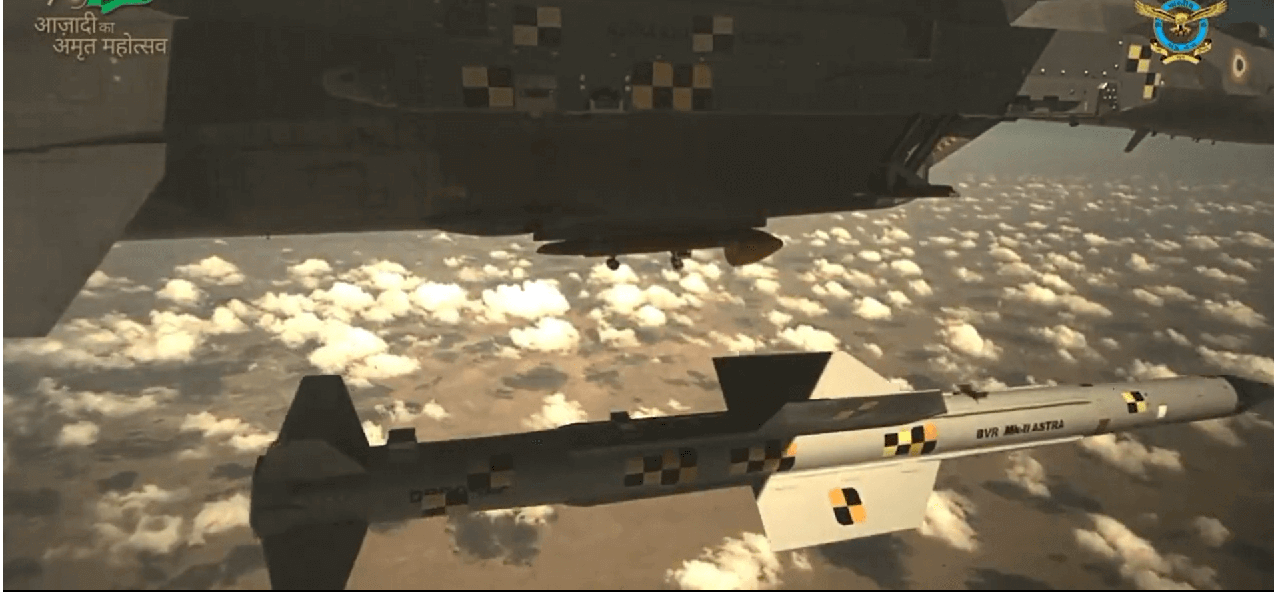India’s defense sector has reached a key milestone with the ASTRA Missile. This missile is set to enhance air combat capabilities and make its mark in the global arms market. The question now is: which countries might be interested in the ASTRA?
India’s ASTRA Missile
The Astra, India’s first indigenously developed beyond-visual-range air-to-air missile (BVRAAM), marks a significant milestone in the country’s defense capabilities. Engineered by the Defence Research and Development Organisation (DRDO) and manufactured by Bharat Dynamics Limited (BDL), the Astra is positioned as a superior alternative to the widely-used Russian R-77 missile.
Vinod Kumar, General Manager of New Projects at BDL, recently stated, “Astra is currently in production, and we anticipate receiving additional orders. We are also exploring the possibility of exporting the Astra missile.” This statement underscores India’s growing confidence in its indigenous defense technology and its ambitions in the global arms market.
The Astra has successfully completed rigorous testing and integration with the Sukhoi-30 fighter jet and is now fully operational. Plans are underway to expand its deployment, including integration with India’s homegrown Light Combat Aircraft (LCA) Tejas.
In August 2023, the Tejas LSP-7 successfully test-fired the Astra missile off the coast of Goa, demonstrating its capability to engage targets beyond 100 kilometers.
Building on this success, the Indian Air Force has cleared BDL to produce an additional 200 Astra-Mark 1 missiles. The Defense Acquisition Council approved this project, valued at over Rs 2,900 crore ($362.5 million), in 2022-23. Once produced, these Astra missiles will be integrated into both the Russian-origin Su-30 and the indigenous LCA Tejas fighter aircraft.
ASTRA’s Capabilities
The ASTRA missile system represents a significant leap forward in India’s air combat capabilities. Developed indigenously, it offers a cost-effective alternative to imported missiles while delivering impressive performance. According to BDL, the missile has demonstrated an accuracy rate exceeding 90% during trials and an operational range of over 100 kilometers.
ASTRA’s advanced features make it a formidable weapon in aerial warfare. Its extended range allows for true beyond-visual-range (BVR) engagements, enabling pilots to target adversaries well beyond their line of sight. The missile’s operational ceiling of up to 20 kilometers ensures it can effectively engage threats across a wide spectrum of combat scenarios.
The missile’s design prioritizes effectiveness and efficiency. Measuring 3840 mm in length and 178 mm in diameter, ASTRA’s sleek, aerodynamic profile enhances its maneuverability in flight. Its high-explosive pre-fragmented warhead delivers a lethal impact on the target.
ASTRA’s performance characteristics are equally impressive. Capable of achieving speeds up to Mach 4.5, the missile provides rapid response and interception capabilities crucial in modern air combat. With a flight duration of 100 to 120 seconds, ASTRA can swiftly neutralize threats, a capability thoroughly validated through extensive trials conducted by DRDO on various platforms, including the indigenous Tejas fighter.
The sophistication of ASTRA extends to its guidance system. Utilizing a combination of inertial guidance, mid-course updates, and terminal active radar homing (effective at 13 km), the missile ensures high precision in target engagement. This advanced guidance, coupled with its resistance to electronic countermeasures (ECM), significantly enhances the Indian Air Force’s combat effectiveness.
ASTRA’s combination of cost-effectiveness, accuracy, and advanced features makes ASTRA a competitive option in the global arms market.
Russia To Boost Su-57 Stealth Fighter’s Production With New Facilities At KnAAZ Aviation Plant
Potential Customers For ASTRA Missiles
As India’s ASTRA missile system gains recognition for its advanced capabilities, BDL is actively exploring export opportunities. The primary focus for potential customers centers on nations that operate Sukhoi-30 fighter aircraft, as the ASTRA has been successfully integrated and tested on this platform.
Reports indicate that BDL has already initiated discussions with at least one Sukhoi-30 operator regarding the potential export of the indigenously developed ASTRA BVRAAM. This development also signals growing international interest in India’s defense technology.
The list of potential customers spans multiple continents, including countries in Southeast Asia, South America, and Africa. Nations such as Vietnam, Myanmar, Malaysia, Venezuela, Uganda, Indonesia, Angola, and Algeria are among those that could potentially benefit from the ASTRA system.
These countries currently operate Sukhoi-30 variants, making the integration of ASTRA a feasible and attractive option for enhancing their air combat capabilities.
What makes the ASTRA particularly appealing to these nations is its compatibility with Russian-made aircraft, coupled with its reported superiority over the widely-used R-77 missile.
This combination of familiarity and enhanced performance could provide a compelling argument for countries looking to upgrade their air-to-air missile capabilities without extensive modifications to their existing fighter fleets.

‘Made in India’ Sukhoi-30 for Export
India’s ambitious defense sector plans extend beyond missile systems to include the production of advanced fighter aircraft for export.
According to a July 2024 Financial Express report, Hindustan Aeronautics Limited (HAL), India’s state-owned aerospace company, is in negotiations with Russia to manufacture Sukhoi Su-30 fighters for the international market.
These discussions center around utilizing HAL’s Nashik facility for the production of these renowned fighter jets. Russia, the original developer of the Sukhoi aircraft, has reportedly agreed to support this endeavor, further strengthening the strategic partnership between the two nations.
The IAF currently operates a substantial fleet of approximately 260 Sukhoi-30MKI aircraft. Of these, 40 were directly procured from Russia, while HAL locally manufactured the remaining 222 fighters. To maintain squadron strength and address attrition losses, the Indian government approved a budget in September 2023 for the acquisition of an additional 12 Su-30 MKIs.
HAL has demonstrated its capabilities not only in production but also in maintenance and upgrades. The company has achieved the capacity to perform major maintenance on 20 Su-30 fighters annually.
Furthermore, HAL is preparing to initiate a comprehensive modernization program for the IAF’s entire Su-30MKI fleet. This ambitious project aims to elevate these aircraft to a technological level comparable with advanced Western fighters like the F-15EX, Rafale F4, Gripen NG, and the proposed Eurofighter LTE, particularly in terms of avionics and electronics.
The technology transfer and extended license manufacturing agreement between India and Russia could have far-reaching implications. Beyond facilitating maintenance and modernization work on India’s own fighter jets, it opens up exciting possibilities in the international market.
This development could position India as a potential supplier for other countries operating Su-30 variants, offering not just the aircraft but also comprehensive maintenance and upgrade packages.

Global Ambitions
India’s defense sector is making bold strides towards establishing itself as a global player, with ambitious plans that span both aircraft and missile technologies. The synergy between these developments is positioning India to offer comprehensive defense packages on the international market.
The ASTRA missile program, spearheaded by the Defense Research and Development Organisation (DRDO) and the Indian Air Force (IAF), continues to advance steadily.
Current efforts are focused on the development and testing of the ASTRA-Mark 2 variant, which aims to extend the missile’s range to approximately 130 kilometers. Even more ambitious plans are underway to create a long-range version of the ASTRA, with a projected strike capability of up to 300 kilometers.
These advancements in missile technology, coupled with India’s progress in fighter aircraft production, could create a powerful combination for potential exports. The ability to offer advanced Sukhoi Su-30 fighters equipped with cutting-edge ASTRA missiles presents a compelling package for international buyers.
The potential for indigenous ASTRA exports represents more than just a business opportunity; it signifies India’s growing self-reliance in defense technologies and its emergence as a significant player in the international arms trade.
These developments also highlight the rapidly growing capabilities of India’s domestic aerospace industry. It demonstrates the country’s transition from being primarily an importer of defense technology to becoming a developer and exporter of advanced military systems.
The combination of indigenous fighter aircraft production, advanced missile systems, and a growing focus on exports signals India’s determination to establish itself as a major force in the international defense industry.
- Shubhangi Palve is a defense and aerospace journalist. Before joining the EurAsian Times, she worked for E.T. Prime. In this capacity, she focused on covering defense strategies and the defense sector from a financial perspective. She offers over 15 years of extensive experience in the media industry, spanning print, electronic, and online domains.
- Contact the author at shubhapalve (at) gmail (dot) com.




